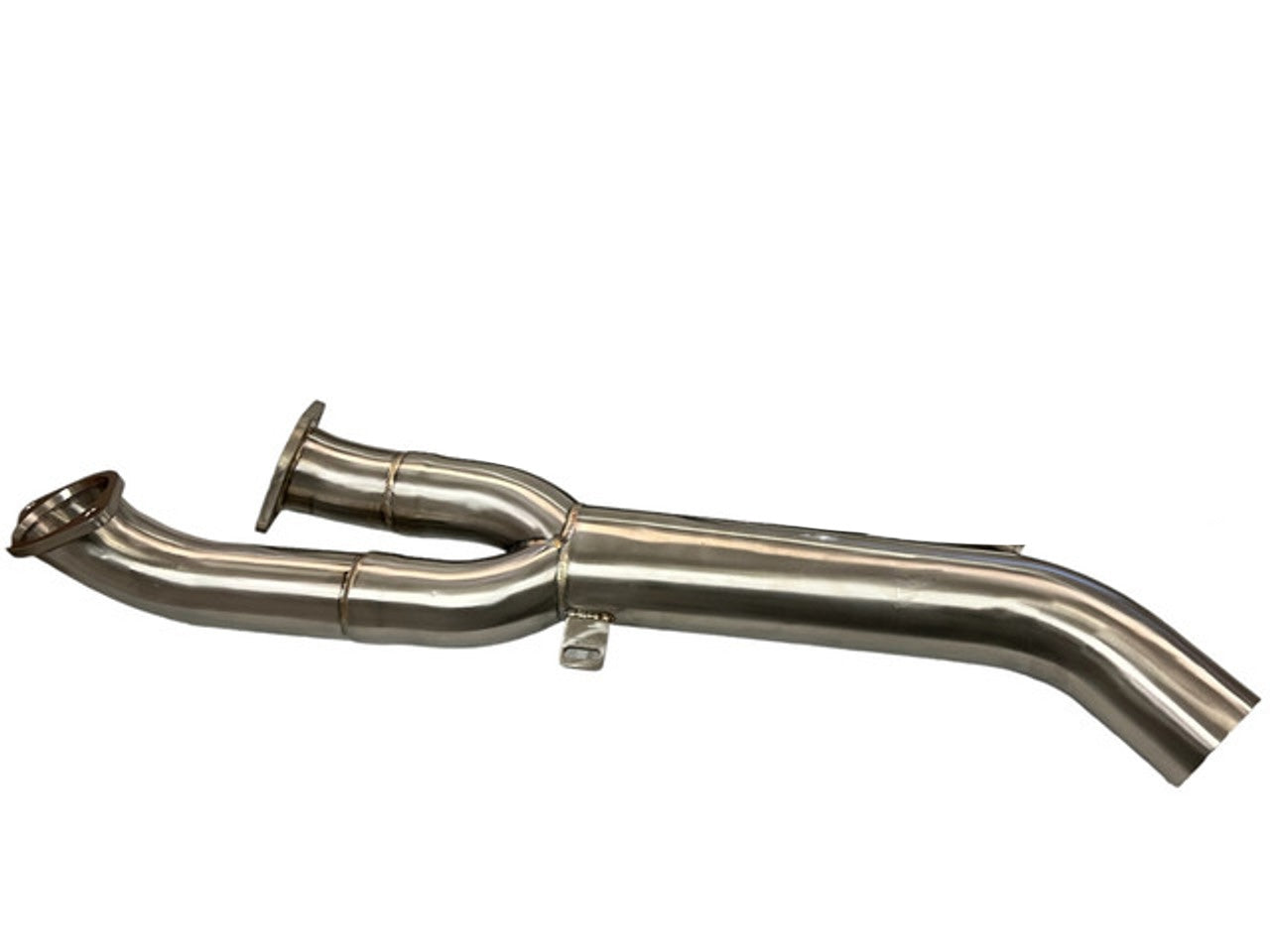Looking to upgrade your exhaust, but want to know the best options for you? This blog post dives into the benefits of an aftermarket exhaust system and the different types to choose. From cat-back, axle-back, GPF/OPF-back exhaust systems, and even delves into H-pipes vs. X-pipes to help you find the perfect sound and performance boost for your car.

What is a cat-back / OPF-delete exhaust system?
A cat-back / OPF-delete exhaust system is a performance upgrade for vehicles that replaces a portion of the exhaust system starting after the catalytic converter. It includes:
- Centre pipe: The connecting pipe between the catalytic converter and the silencer.
- Silencer: The component that controls sound level and tone. (Sometimes called a "back box" in the UK)
- Tailpipe: The final section where exhaust gases exit.
Benefits of a cat-back exhaust system:
- Improved Sound: Cat-back / OPF-delete systems usually offer a sportier, more assertive exhaust note compared to standard exhausts.
- Modest Performance Gains: The larger diameter piping and less restrictive silencers can provide a slight increase in horsepower and torque.
- Appearance: Aftermarket cat-back systems often feature larger, polished exhaust tips for a more customised look.
- Weight Reduction: Some aftermarket systems can be lighter than standard components.
Disadvantages of a cat-back exhaust system:
- Emissions: In the UK this will fail an MOT and considered illegal as a result.
- Warranty: A cat-back / OPF-delete will very likely void your warranty.
- Cost: Quality cat-back / OPF-delete systems can be expensive.
- Potential Drone: Some aftermarket systems may produce an undesirable resonating hum ("drone") at certain RPM ranges.
Important Considerations:
- Emissions: Cat-back systems are generally emissions legal as they don't modify the catalytic converter.
- Sound Level: Be sure the exhaust note of your chosen system suits your preferences, as some cat-back systems can be quite loud.
- OPF-Delete Module: This system may require OPF-Delete modules. These are plug-in modules that ‘trick’ the ECU into thinking the OPFs are still installed.

What is a GPF/OPF-back exhaust system?
- GPF stands for Gasoline Particulate Filter.
- OPF stands for Otto Particulate Filter (essentially the same as a GPF, but used with some diesel engines).
These filters are a relatively recent addition to the exhaust systems of many gasoline and some diesel vehicles to meet stricter emissions standards. A GPF/OPF-back exhaust system replaces the exhaust components located after the GPF or OPF. This typically includes:
- Mid/Centre Pipe: The pipe connecting the GPF/OPF to the rear of the exhaust.
- Muffler/Silencer: Controls noise and exhaust tone.
- Tailpipe: Final exit point of exhaust gases.
Advantages of a GPF/OPF-back exhaust system:
- Improved Sound: Many owners install these systems to enhance their vehicle's exhaust note, often making it louder and sportier, remaining daily-drivable.
- Potential for Modest Performance Increases: Aftermarket systems may have larger diameter piping and a less restrictive back box / muffler, possibly leading to slight gains in power and torque.
- Visual Upgrade: Some systems offer a variety of exhaust tip options and unique designs for a customised appearance.
Disadvantages of a GPF/OPF-back exhaust system:
- Cost: Aftermarket exhaust systems designed to fit cars with GPFs/OPFs can be expensive.
- Limited Performance Gains: The GPF/OPF remains the primary restriction in the exhaust, meaning horsepower and torque gains compared to a full turbo-back system are less noticeable.
- Possible Drone: Some systems may introduce a droning noise at certain speeds, which can be bothersome.
- Potential Emissions Issues: While GPF/OPF-back systems don't directly affect emissions equipment, some louder systems may exceed legal noise limits in certain regions.
- Not as loud: Other variants such as a cat-back offer a greater noise enhancement.
Important Considerations
- Legality: Ensure the chosen exhaust system complies with any regional noise regulations.
- Priorities: If your main goal is improving the sound, a GPF/OPF-back system might be sufficient. For maximum power increases, a full system replacing the GPF/OPF would be necessary (though this may have emissions implications).

What is an axle-back exhaust system?
An axle-back exhaust system is the simplest and most budget-friendly performance exhaust modification. It replaces only the components of the exhaust system located behind the rear axle. This usually includes:
- Silencer / Muffler: The component responsible for controlling exhaust noise and tone.
- Exhaust Tips / Tailpipe(s): The final visible section where exhaust gases exit.
Advantages of an axle-back exhaust system:
- Affordability: Axle-back systems are usually the least expensive aftermarket exhaust upgrade option.
- Improved sound: The primary reason for getting an axle-back is to create a more aggressive or desirable exhaust note.
- Easy installation: Axle-backs often require simple bolt-on installation, making them DIY-friendly for some car enthusiasts.
- Appearance: Many axle-back systems offer larger, polished exhaust tips for a customised look.
Disadvantages of an axle-back exhaust system:
- Very limited performance gains: Since the stock catalytic converter, resonator, and most of the piping remain untouched, power and torque increases are minimal.
- Potential for drone: Some aftermarket mufflers can introduce an undesirable resonating hum ("drone") inside the vehicle at specific RPMs.
- Less dramatic sound change: Axle-backs offer a milder change in sound compared to cat-back or turbo-back systems.
When to consider an axle-back system:
- You're primarily interested in changing the tone and aesthetic of your exhaust.
- You're on a tight budget and want an easy to install modification.
- You don't require significant horsepower or torque gains.
What is a Centre Pipe or Mid-Pipe?
Replacing the centre pipe or mid-pipe of your exhaust system with an aftermarket is a modification that deletes the centre resonators or OPF.
Note: removing your OPF is considered illegal for UK road use. Please ensure you check your regional regulations.

What is a De-Cat?
This is a modification where the catalytic converters are removed with an aftermarket replacement, potentially leaving the rest of the exhaust stock.
Note: removing your catalytic converter is considered illegal for UK road use. Please ensure you check your regional regulations.
Choosing Your Performance Exhaust:

H-Pipe vs. X-Pipe
When it comes to upgrading your exhaust system for a throatier sound and potential performance gains, two main options often dominate the conversation: H-pipes and X-pipes. But what's the difference, and which is right for your car?
Understanding the Designs
- H-Pipe: This classic design is shaped like the letter "H." It connects the two sides of your exhaust system to balance exhaust flow. Some H-pipes may have split branches to further optimise performance.
- X-Pipe: Resembling the letter "X," this design is like two H-pipes stacked with a crossbar. The X-pipe merges the exhaust flow from both engine banks for potential improvements in scavenging (how well an engine pulls fresh fuel and air into the cylinders).
Key Differences
- Sound: H-pipes tend to produce a deeper, more traditional muscle car rumble, while X-pipes often have a higher-pitched, raspy note.
- Performance: H-pipes generally offer better high-RPM power due to their more direct exhaust flow. X-pipes can improve low-RPM torque and responsiveness due to enhanced scavenging effects.
- Cost: H-pipes are usually more affordable than X-pipes, which have a slightly more complex design.
Which One to Choose?
The best option depends on your priorities:
- Maximum high-end power: Go for an H-pipe
- Improved low-end torque and a racier sound: Consider an X-pipe.
- Budget-conscious sound upgrade: An H-pipe may be the better choice

Exhaust Materials
Mild steel
Normally what OEM exhausts and made of, even for premium sports and performance vehicles. Made with a mix of iron and carbon these are the cheapest to produce. Heavy and generally low quality.
OEM
Stainless Steel
A more premium variant of steel exhaust. Used by brands like Remus and Milltek. Generally made with 409 stainless, they weight similar to stock systems, but less likely to corrode and last longer.
Brands: Milltek Sport, Remus, Akrapovic
Titanium
Some selected performance vehicles come with these from factory. This is the lightest available option for “normal” supercars and performance vehicles. Used by premium aftermarket exhaust suppliers.
Brands: Boost logic, Akrapovic
Inconel
Reserved for hyper-cars and top end supercar exhaust systems. Inconel is a material usually used for rockets rather than road cars. We’ll likely see more of these in the future.
Brands: JCR, Kline, 1016 industries
Which exhaust did we go for on our G87 M2?
We have been working alongside Milltek to produce the best exhaust system for BMW G87 M2. Our BMW G87 M2 now runs a Milltek single mid pipe non resonated to Milltek Axle back system.
We think this has transformed the sound that is a unique rasp to the S58 engine. Watch our video to see how it sounds.
Are you interested in an exhaust system for your vehicle? Take a look at our store to see what we offer or give a member of our team a call for expert advice.































Leave a comment
All comments are moderated before being published.
This site is protected by reCAPTCHA and the Google Privacy Policy and Terms of Service apply.